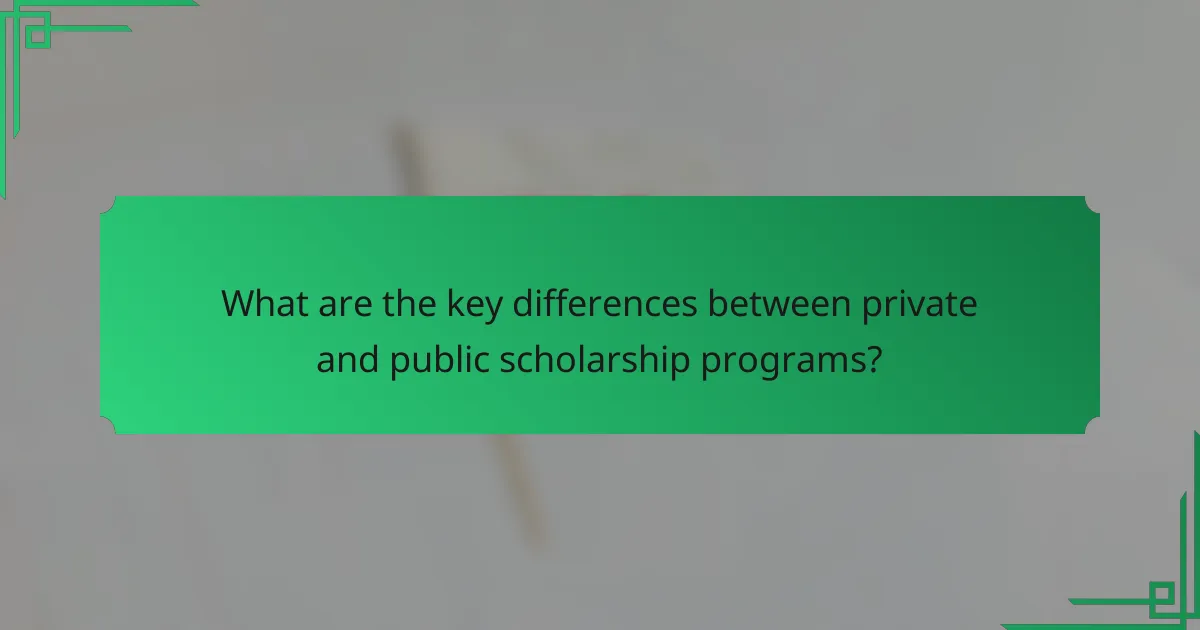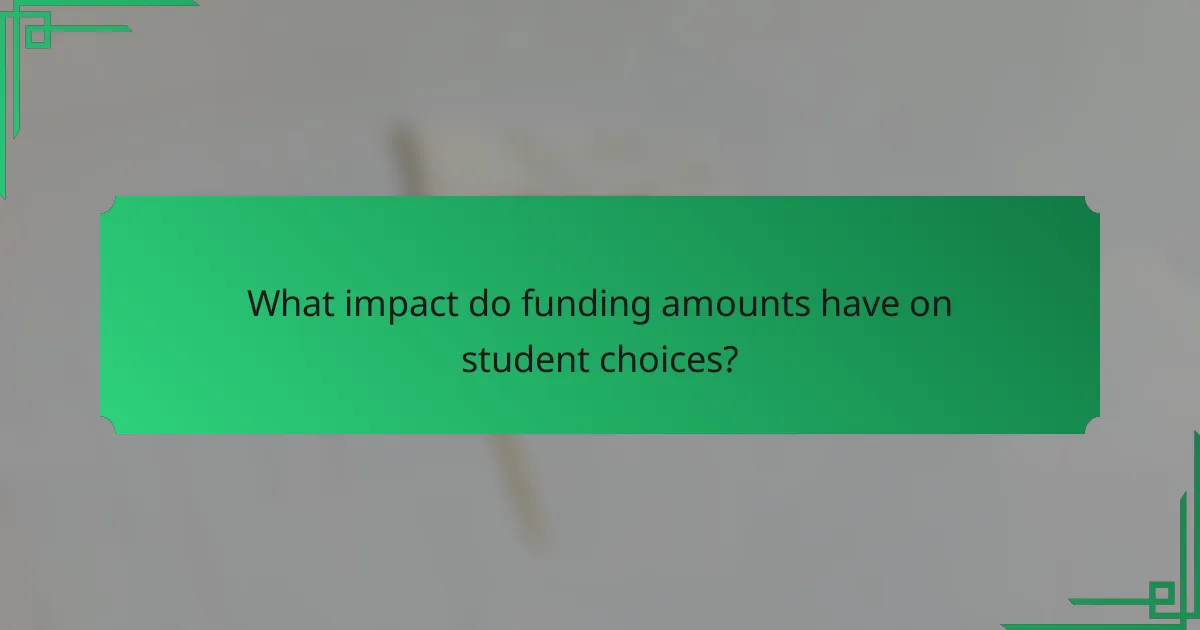
What are the key differences between private and public scholarship programs?
Private scholarship programs are funded by individuals, organizations, or foundations, while public scholarship programs are funded by government entities. Private scholarships often have specific eligibility criteria set by the donor, such as academic achievement or community service. Public scholarships typically have broader eligibility requirements and may be based on financial need or residency. Funding amounts for private scholarships can vary widely, often depending on the donor’s resources. Public scholarships usually offer standardized amounts set by government policies or budgets. Private scholarships may be less competitive due to a smaller applicant pool, while public scholarships can be highly competitive due to larger applicant numbers.
How do funding amounts vary between private and public scholarship programs?
Funding amounts typically differ significantly between private and public scholarship programs. Public scholarship programs often receive government funding, leading to larger and more standardized awards. For example, federal Pell Grants can provide up to $6,495 per year for eligible students. In contrast, private scholarship programs are funded by organizations, foundations, or individuals, resulting in a wide range of award amounts. Some private scholarships may offer as little as $500, while others can provide up to $50,000 or more. The variability in private scholarships stems from differing criteria and funding sources. Therefore, while public scholarships tend to have a more uniform funding structure, private scholarships are characterized by greater variability in their amounts.
What factors influence the funding amounts of private scholarship programs?
Funding amounts of private scholarship programs are influenced by several key factors. The financial capacity of the sponsoring organization plays a significant role. Wealthy foundations can offer larger scholarships. The specific goals and mission of the scholarship program also affect funding levels. Programs targeting underrepresented groups may receive more support. Additionally, the number of applicants impacts funding decisions. A higher number of applicants may lead to more competitive funding amounts. Economic conditions can alter the available funds for scholarships. In times of economic downturn, donations may decrease, affecting scholarship sizes. Finally, the visibility and outreach of the scholarship program can influence funding. Programs that effectively market themselves may attract more donations.
What factors influence the funding amounts of public scholarship programs?
Funding amounts of public scholarship programs are influenced by several key factors. Government budget allocations play a significant role in determining available funds. Economic conditions also impact funding levels, as tighter budgets may reduce scholarship amounts. Legislative changes can influence funding through new laws or policies affecting education finance. Additionally, public demand for education and scholarship programs can drive funding increases. Lastly, institutional partnerships and donations can supplement government funding, enhancing overall scholarship amounts.
What are the eligibility criteria for private and public scholarship programs?
Eligibility criteria for private and public scholarship programs vary. Common criteria include academic performance, financial need, and enrollment status. Many scholarships require a minimum GPA, often around 2.5 to 3.0. Some programs focus on specific fields of study or demographics, such as minority groups or first-generation college students. Public scholarships may require state residency or attendance at a state institution. Private scholarships often have unique criteria set by their donors. Applicants typically must submit essays, letters of recommendation, or personal statements. Deadlines for applications can vary significantly between programs. These criteria ensure that scholarships target deserving candidates effectively.
How do academic requirements differ between private and public scholarships?
Academic requirements for private and public scholarships often differ significantly. Public scholarships typically require applicants to meet specific state or federal guidelines. These may include maintaining a minimum GPA, completing standardized tests, or demonstrating financial need. In contrast, private scholarships may have more flexible criteria. They can vary widely based on the organization’s mission or the scholarship’s specific focus. Some private scholarships prioritize community service or leadership experience over academic metrics. Public scholarships often have a broader applicant pool, while private scholarships may target niche groups. This distinction can impact the number of applicants and the competitiveness of the awards.
What financial need assessments are used in private vs. public scholarships?
Private scholarships often use the Free Application for Federal Student Aid (FAFSA) as a financial need assessment. This application provides a standardized measure of a student’s financial situation. Some private scholarships may also require additional documentation, such as tax returns or income statements, to evaluate need more precisely.
Public scholarships primarily rely on the FAFSA as well. They may also consider state-specific financial assessments or criteria set by the state government. Public scholarships often have more structured guidelines for assessing financial need compared to private options.
Both types of scholarships aim to evaluate a student’s ability to pay for education. However, private scholarships may have more flexibility in their assessments. Public scholarships typically adhere to government-established criteria. This distinction can affect the accessibility of funds for students.
What are the advantages and disadvantages of private and public scholarship programs?
Private scholarship programs often offer larger funding amounts and more flexibility in eligibility criteria. They can target specific demographics or fields of study, which can benefit niche groups. However, they may lack transparency and vary significantly in quality and reliability. Public scholarship programs, on the other hand, generally provide more consistent funding and are often well-regulated. They aim to serve a broader population, ensuring equitable access to education. Yet, public programs may have stricter eligibility requirements and limited funding amounts. Overall, private scholarships can provide tailored opportunities, while public scholarships ensure wider access and stability.
What unique benefits do private scholarship programs offer?
Private scholarship programs offer unique benefits such as targeted financial support and flexibility in eligibility criteria. They often cater to specific demographics or fields of study, allowing students to find funding that aligns with their unique circumstances. Many private scholarships provide additional resources like mentorship and networking opportunities, enhancing the overall educational experience. According to the National Scholarship Providers Association, private scholarships can fill gaps left by federal and state funding, ensuring that students can afford their education. Additionally, private scholarship programs may have fewer applicants compared to public scholarships, increasing the chances of receiving aid.
What unique benefits do public scholarship programs offer?
Public scholarship programs offer unique benefits such as increased accessibility to education. They often provide financial support to underrepresented communities. This support helps reduce the financial burden of tuition fees. Public scholarships can also promote diversity within educational institutions. They frequently encourage students to pursue fields that address public needs. Many public scholarship programs are funded by government sources, ensuring sustainability. This funding often results in larger scholarship amounts compared to private programs. Additionally, public scholarships may include mentorship opportunities and networking resources. These benefits contribute to a more equitable educational landscape.
How do the application processes differ for private and public scholarship programs?
Private and public scholarship programs have distinct application processes. Public scholarship programs typically require applicants to fill out standardized forms, such as the FAFSA in the United States. This form assesses financial need and determines eligibility for federal and state aid. Public programs often have set deadlines and eligibility criteria defined by government regulations.
In contrast, private scholarship programs may have varied application requirements. Each private scholarship may have its own unique application form and criteria. These programs can require essays, letters of recommendation, and specific documentation related to academic or extracurricular achievements.
Public scholarships are generally more uniform in their requirements. Private scholarships offer more flexibility but also more variability in expectations. The differences in application processes reflect the funding sources and administrative structures of each type of program.
What documents are typically required for private scholarship applications?
Private scholarship applications typically require several key documents. Commonly requested items include an application form, which provides personal and academic information. Many scholarships also ask for transcripts to verify academic performance. Letters of recommendation from teachers or mentors are often necessary to support the application. A personal essay is frequently required, allowing applicants to express their goals and motivations. Financial information, such as a FAFSA form or family income details, may also be requested to assess need. Some scholarships might ask for proof of extracurricular involvement or community service. Each scholarship may have specific requirements, so applicants should carefully review guidelines.
What documents are typically required for public scholarship applications?
Public scholarship applications typically require several key documents. These documents often include a completed application form. Applicants usually need to submit proof of eligibility, such as transcripts or diplomas. Financial information, like a FAFSA report, is often required to assess need. Additionally, letters of recommendation from teachers or mentors may be necessary. A personal statement or essay detailing the applicant’s goals is commonly requested. Some programs may also ask for a resume or CV highlighting achievements. Each scholarship may have specific requirements that can vary, so applicants should review guidelines carefully.

What impact do funding amounts have on student choices?
Funding amounts significantly influence student choices regarding education. Higher funding typically increases access to preferred institutions and programs. Students often select schools based on available financial aid. Research shows that students with substantial scholarships are more likely to attend private colleges. A study by the National Center for Education Statistics found that financial aid affects enrollment decisions. Specifically, 70% of students stated that funding influenced their college choice. Additionally, funding disparities can lead to unequal access to resources. This can affect students’ academic and career prospects.
How do funding amounts affect enrollment decisions?
Funding amounts significantly influence enrollment decisions in educational institutions. Higher funding often leads to increased scholarship availability. This makes education more accessible for students from diverse economic backgrounds. For instance, institutions with substantial endowments can offer larger scholarships, attracting more applicants. Conversely, schools with limited funding may struggle to enroll students who require financial aid. Research shows that a 10% increase in scholarship funding can boost enrollment by up to 5% in competitive programs. Therefore, funding amounts directly correlate with the number of students enrolling in programs.
What role does scholarship funding play in student debt levels?
Scholarship funding significantly reduces student debt levels. Scholarships provide financial assistance that lessens the amount students need to borrow. According to the National Center for Education Statistics, students who receive scholarships typically graduate with lower debt. In 2020, the average debt for scholarship recipients was about $20,000 less than for non-recipients. This reduction in borrowing can lead to better financial stability post-graduation. Additionally, scholarships can increase college access for low-income students, further impacting overall debt levels. As more students receive scholarships, the collective student debt burden decreases.
What trends are emerging in scholarship funding?
Emerging trends in scholarship funding include increased private sector involvement and a focus on diversity. Private organizations are providing more scholarships, often targeting specific demographics. This shift has led to a rise in funding amounts, with some private scholarships exceeding $100,000. Additionally, there is a growing emphasis on supporting underrepresented groups in higher education. Public funding is also evolving, with states allocating more resources for need-based scholarships. Programs are increasingly utilizing technology to streamline applications and enhance accessibility. These trends reflect a broader commitment to making education more equitable and accessible.
How are private scholarship funding amounts changing in recent years?
Private scholarship funding amounts have been increasing in recent years. According to the National Scholarship Providers Association, private scholarships awarded over $1 billion in 2020, reflecting a growing trend. The increase is driven by a rise in donor interest and the need for financial aid. Additionally, many organizations are expanding their scholarship programs to cover more diverse student populations. Data from the College Board indicates that private scholarships are becoming more competitive, with larger awards being offered. This shift is essential as students face rising tuition costs. Overall, the landscape of private scholarship funding is evolving positively to meet educational financial needs.
What are the current trends in public scholarship funding amounts?
Current trends in public scholarship funding amounts indicate a gradual increase. According to the National Association of Student Financial Aid Administrators, public scholarship funding has risen by approximately 5% annually over the last three years. This growth is attributed to increased state budgets allocated for education. Additionally, federal initiatives have expanded funding opportunities for underrepresented students. Recent data from the U.S. Department of Education shows that public scholarship programs now offer an average of $4,500 per recipient. This amount reflects a focus on making higher education more accessible. Overall, the trend suggests a commitment to enhancing public scholarship programs in response to rising educational costs.

What resources are available for students seeking scholarships?
Students seeking scholarships have various resources available to them. These include scholarship search engines, school counseling offices, and financial aid websites. Popular scholarship search engines like Fastweb and Cappex list numerous opportunities. Many colleges and universities also offer scholarships directly through their financial aid offices. Additionally, nonprofit organizations and community foundations provide local scholarship options. Government websites, such as the U.S. Department of Education, offer information on federal scholarships. Students can also explore professional associations related to their intended fields for specialized scholarships. Utilizing these resources can significantly enhance students’ chances of securing funding for their education.
How can students find private scholarship opportunities?
Students can find private scholarship opportunities through several methods. They can search online databases dedicated to scholarships. Websites like Fastweb and Cappex list numerous private scholarships. Students should also check with their schools for local scholarship resources. Community organizations and foundations often offer scholarships as well. Networking with local businesses can uncover additional opportunities. Attending college fairs may provide information on private scholarships. Finally, students should utilize social media groups focused on scholarship sharing.
What online platforms are best for locating private scholarships?
Fastweb, Cappex, and Niche are among the best online platforms for locating private scholarships. Fastweb offers a comprehensive database with personalized matches based on user profiles. Cappex connects students with scholarships and colleges, allowing users to search by specific criteria. Niche provides a user-friendly interface for finding scholarships based on academic interests and demographics. These platforms aggregate information from various sources, making it easier for students to discover available funding. Each platform has unique features, enhancing the scholarship search experience.
How can students find public scholarship opportunities?
Students can find public scholarship opportunities through various online platforms and resources. Websites such as Fastweb, College Board, and Scholly aggregate scholarship listings. State education departments often provide information on local scholarships. Many universities also have dedicated scholarship offices that list public funding options. Additionally, community organizations and non-profits may offer scholarships for residents. It’s essential for students to regularly check these resources for updates. Networking with school counselors can also help identify opportunities. These methods collectively enhance students’ chances of securing public scholarships.
What government resources are available for public scholarships?
Government resources available for public scholarships include federal, state, and local programs. The U.S. Department of Education administers federal financial aid, including Pell Grants and federal student loans. State governments provide various scholarship programs based on residency and academic performance. Local governments and school districts may also offer scholarships funded by community organizations. These resources aim to increase access to higher education for eligible students. According to the National Association of Student Financial Aid Administrators, over $120 billion is awarded annually through federal student aid programs.
What tips can help students maximize their scholarship funding?
Students can maximize their scholarship funding by applying to a wide range of scholarships. This includes both private and public scholarship programs. Research shows that students who apply for multiple scholarships increase their chances of receiving funding. It is also beneficial to tailor applications to match the specific criteria of each scholarship. Personalizing essays and highlighting relevant experiences can make applications stand out. Additionally, meeting all deadlines is crucial. Late applications are often disqualified. Networking with scholarship providers can provide valuable insights. Engaging with alumni who received scholarships can offer tips and guidance. Finally, maintaining a strong academic record is essential, as many scholarships consider GPA as a key factor.
The main entity of the article is the comparison between private and public scholarship programs. The article outlines the key differences in funding sources, eligibility criteria, and application processes for both types of scholarships. It highlights how private scholarships are typically funded by individuals or organizations with specific criteria, while public scholarships are government-funded with broader eligibility requirements. Additionally, the article discusses factors influencing funding amounts, advantages and disadvantages of each program, and emerging trends in scholarship funding. It also provides resources and strategies for students seeking scholarships to maximize their funding opportunities.



